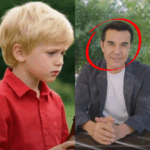🚀 “Dragon Capsule Returns: Inside India’s Historic Spacewater Landing and Astronaut Rescue”
In an extraordinary display of human ambition, technology, and engineering finesse, the Dragon Capsule carrying three astronauts – including India’s mission pilot Subhanshu Shukla – safely splashed down in the ocean and was lifted onto the rescue platform, marking a triumphant conclusion to their historic space journey.
The Tense Moments of Return
As the capsule descended, reporters and mission experts narrated each critical second.
“Now how will it be lifted up?” the anchor asked, pointing to the massive platform constructed on a giant boat to receive the capsule. Experts explained that the Dragon capsule weighs around nine tonnes (dry weight), demanding specialized shock-absorbing platforms to ensure its safe placement without damage.
The capsule floated gently towards the rescue ship, tethered by multiple ropes for stability.
“See how it’s floating, tied securely by many ropes to the large boat,” they described. Within moments, the powerful cranes lifted it clear off the water. Water droplets cascaded from its surface as the capsule swayed mid-air, revealing its sealed bottom to the cameras.
Slowly, with utmost precision, it was lowered onto the platform.
“Just a few feet away now… it will soon be placed exactly at its designated spot,” the commentator added, highlighting the delicate choreography required to absorb the impact of such weight.
Inside: Three Heroes Return
The capsule carried three astronauts – from India, Poland, and Hungary – returning from the International Space Station (ISS). For India, this marked only the second time an Indian astronaut has ventured into space since Rakesh Sharma’s legendary mission in 1984. Naturally, public emotions ran high.
“Now is the moment of joy… we can’t wait to see Subhanshu Shukla’s smiling face,” reporters exclaimed as ground crews prepared to open the hatch.
Opening the Hatch: The Final Step
The capsule, now anchored securely on the platform, awaited its final welcome. Rescue workers climbed up, unfastening locks, disinfecting the exterior, and ensuring all procedures were followed with zero contamination risk.
“Disinfection is critical,” experts said. “We don’t know what bacteria went up or came down.”
As they cleaned the hatch area, viewers noticed water or chemical sprays being used extensively, followed by wiping to sterilise surfaces before entry.
Why The Hatch Opening Takes Time
Ground control maintained strict authority over every step. Although Subhanshu Shukla, the mission pilot, had access to onboard controls, final commands for unlocking came from the rescue team as per SOP (Standard Operating Procedure).
“The astronauts inside can only communicate parameters such as internal air pressure and temperature to ground control,” experts explained. “The actual mechanical unlocking remains the ground team’s responsibility to avoid any sudden pressure imbalances or structural mishaps.”
The Science Experiments Onboard
During this mission, Subhanshu Shukla conducted groundbreaking biological experiments crucial for humanity’s future in space:
Cyanobacteria Growth:
Testing how photosynthetic bacteria manage oxygen-carbon dioxide balance in microgravity, potentially enabling self-sustaining life support systems for long-duration missions to Mars or lunar bases.
Growing Fenugreek and Mung Beans:
Experiments showed unexpectedly rapid growth rates for fenugreek (methi) and mung beans in microgravity due to lack of gravitational resistance, potentially revolutionising space farming and food supply for astronauts.
“Leaves were small and beautiful,” scientists observed, adding that previous ISS experiments included growing lettuce and even pizza-making in space, highlighting the importance of reliable fresh food sources for psychological and nutritional health.
A Moment Of National Pride
As the wait extended, tension grew outside the capsule and inside the newsroom.
“Now only mechanical procedures remain,” the anchor sighed. “The technical challenges are over; we’re just waiting for the door to open so we can finally see Subhanshu safe and smiling.”
Another expert compared the capsule’s airtight hatch to airplane doors, emphasising the importance of ensuring perfect sealing under pressure differences experienced during re-entry.
“Remember, even on aircraft flying at 35,000 feet, cabin pressure must remain stable. For space capsules returning from orbit, this is exponentially more critical.”
A Legacy Continued
This successful mission echoes Rakesh Sharma’s historic journey, when he looked down upon Earth and proudly recited “Saare Jahan Se Achha Hindustan Hamara.” Today, Subhanshu Shukla’s experiments and safe return lay the foundation for India’s expanding role in international space exploration, deep space biology, and technological collaboration.
What’s Next For The Crew?
After splashdown and recovery, the astronauts are transported to Houston for post-mission health assessments, data debriefs, and psychological evaluations to study the effects of extended microgravity exposure. Meanwhile, their collected data on cyanobacteria, algae, and rapid plant growth in space will be analysed in detail to guide future food production systems for orbital habitats and lunar or Martian colonies.
Final Moments Of The Broadcast
As the hatch was unlocked, rescue teams prepared stretchers and stairways to assist astronauts out of the capsule, which was disinfected repeatedly to prevent contaminating Earth ecosystems with unknown microbes.
“Just like parking at the ISS, this is like parking on Earth,” joked one commentator as ground staff removed remaining ropes and adjusted orientation for safe exit.
The excitement was palpable.
“Our hearts are beating fast now. We just want to see Subhanshu wave and smile,” the anchor said. Viewers across India, Poland, and Hungary watched live as their heroes prepared to step back onto their home planet.
Beyond The Mission: Humanity’s Future
This landing is not merely the end of a space mission. It is a testament to human curiosity, courage, and our unstoppable desire to explore, learn, and grow beyond Earth. Each capsule, each seed experiment, each smiling astronaut brings us one step closer to becoming a multi-planetary species.
News
Shraddha Kapoor’s Open Romance: The Night Bollywood’s Sweetheart Let Down Her Guard
Shraddha Kapoor’s Open Romance: The Night Bollywood’s Sweetheart Let Down Her Guard In a city where love is often hidden…
Mystery and Heartbreak: The Shocking Truth Behind Shefali Jariwala’s Sudden Death
Mystery and Heartbreak: The Shocking Truth Behind Shefali Jariwala’s Sudden Death In a world obsessed with the glitz and glamour…
Mystery and Heartbreak: The Shocking Truth Behind Shefali Jariwala’s Sudden Death
Mystery and Heartbreak: The Shocking Truth Behind Shefali Jariwala’s Sudden Death In a world obsessed with the glitz and glamour…
The Dharmasthala Exposé: Uncovering the Horrors on Karnataka’s Sacred Riverbanks
The Dharmasthala Exposé: Uncovering the Horrors on Karnataka’s Sacred Riverbanks In the sprawling landscape of Karnataka, where the sacred and…
Tara Sutaria and Veer Pahariya: Love, Betrayals, and Bollywood’s Circle of Secrets
Tara Sutaria and Veer Pahariya: Love, Betrayals, and Bollywood’s Circle of Secrets When it comes to Bollywood, the lines between…
‘Sayara’ Rules Bollywood: Critics, Fans, and Stars Are Awe-Struck as Karan Johar Shares an Emotional Review
‘Sayara’ Rules Bollywood: Critics, Fans, and Stars Are Awe-Struck as Karan Johar Shares an Emotional Review July 2024 has become…
End of content
No more pages to load












